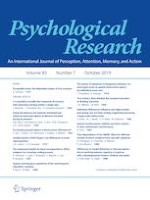16-04-2018 | Original Article
Spontaneous Theory of Mind is reduced for nonhuman-like agents as compared to human-like agents
Gepubliceerd in: Psychological Research | Uitgave 7/2019
Log in om toegang te krijgenAbstract
Theory of Mind research has shown that we spontaneously take into account other’s beliefs. In the current study, we investigate, with a spontaneous Theory of Mind (ToM) task, if this belief representation also applies to nonhuman-like agents. In a series of three experiments, we show here that we do not spontaneously take into account beliefs of nonhuman-like others, or at least we do it to a lesser extent than for human and human-like agents. Further, the experience we have with the other agent, in our case a dog, does not modulate spontaneous ToM: the same pattern of results was obtained when dog owners and no owners were compared. However, when more attention was attracted to the dog behavior, participants’ behavior was influenced by the beliefs of the dog. In sum, spontaneous belief representation seems to be primarily restricted to human and human-like agents, but can be facilitated when more attention is drawn to a nonhuman-like agent.
